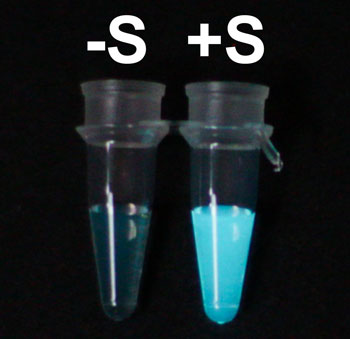| Jul 22, 2015 |
The light of fireflies for medical diagnostics
|
|
(Nanowerk News) In biology and medicine, we often need to detect biological molecules. For example, in cancer diagnostics, doctors need quick and reliable ways of knowing if tumor cells are present in the patient's body. Although such detection methods exist, they often require a lot of time, work and money. EPFL scientists have chemically tweaked the enzyme responsible for the light of fireflies to make it "sniff out" target biological molecules and give out a light signal. The result is a cheap, simple and highly accurate detection system that can change the face of the field. The work, now part of an EPFL startup, is published in Nature Communications
("Modulating protein activity using tethered ligands with mutually exclusive binding sites").
|
 |
| This is an example of the luminescence produced by the chemical modifications described in this article. Key: -S, a tube without streptavidin; +S, with streptavidin. (Image: Kai Johnsson/EPFL)
|
|
The lab of Kai Johnsson at EPFL, led by Alberto Schena and Rudolf Griss, were able to add a small chemical tag on the enzyme luciferase, which produces the light of fireflies. The tag detects a target protein, and the luciferase gives out a light signal that can be seen with a naked eye.
|
|
The team has proven expertise in this field: in 2014, they developed a quick and easy drug-monitoring molecule that led to a startup company, Lucentix. Thinking outside the box, they bypassed the pains of protein engineering altogether: instead of mutating the luciferase to make it sensitive for a target protein - which would require enormous labor - they simply attached it to a small chemical tag.
|
|
The tag acts as a switch: it blocks luciferase, preventing it from producing light. When the tag detects its target protein, it attaches to that instead, removing the block from lucifarase. As a result, luciferase is free to turn on the lights, which is the signal that the target has been found. In short, the scientists have created a chemical solution for a biological problem.
|
|
"You can think of the tagged luciferase as a cyborg molecule," says Kai Johnsson. "Half bio, half synthetic. How could you make luciferase sensitive to the presence of another protein just through mutations? It's a lot of work. With this chemical trick, all we have to worry about is designing an appropriate tag that can recognize the target protein."
|
|
The activation of luciferase when it detects its target protein is dramatic enough to see with a naked eye. This means that the system does not demand expensive and complicated readout devices.
|
|
But the success has wider implications. "This is a generalized design," says Kai Johnsson. "It shows how you can exploit synthetic chemistry to create sophisticated biosensor proteins."
|

